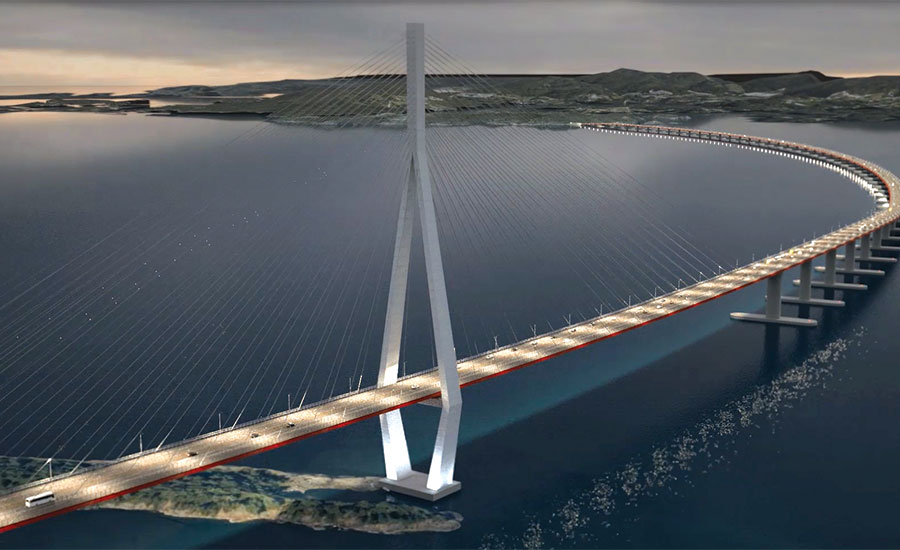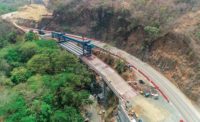While the market for large international design firms is generally positive, there is a growing concern that geopolitical tensions and increasing economic nationalism are making clients nervous, leading to sagging confidence that conditions will continue to thrive. Further, companies worry that clients are becoming more aggressive in their demands in what is perceived as a buyers’ market.
The uncertainty in the market can be seen in the results of ENR’s Top 225 International Design Firms survey. The leading 225 companies generated $71.88 billion in design revenue in 2018 from projects outside home countries, up 11.3% from $64.59 billion in 2017.
However, this rise in revenue is misleading, since this year Wood Group from the U.K. is participating in the survey for the first time and is ranked No. 1 on the list with $5.99 billion in international design revenue. Ignoring Wood’s revenue this year and its U.S. subsidiary’s revenue from last year, design revenue for the Top 225 showed a 2.8% increase in 2018 from 2017.
“Geopolitical instability and high levels of debt—public, corporate and household— are weighing on the design industry as a whole, and this is adding more urgency to clients wanting surety of outcomes.”
– Catherine Tobiasinsky, Chief Client Services Officer, GHD
On the Top 225 International Design Firms list, firms are ranked based on design revenue from projects outside of their home countries, measuring their presence in international commerce. The ENR Top 150 Global Design Firms list measures total worldwide design revenue, regardless of the project location.
There were some shifts on the list this year, mostly from acquisitions. The biggest change, however, won’t be shown until next year. On April 29, 2019, Australia’s WorleyParsons, which will be known simply as Worley pending shareholder approval of the name change in October, finalized its $3.2-billion acquisition of Jacobs’ Energy, Chemicals and Resources division.
Another firm that has been active on the acquisition trail is Australia’s DRA Global Ltd., one of the largest engineering firms in the metals and mining markets. In 2018, DRA acquired Australian engineering firms Minnovo in Perth and G&S Engineering Services in Queensland. And earlier this year, DRA added 300 more people with the acquisition of South Africa-based engineering and project management firm SENET. “By enhancing our offering within the region, DRA is able to provide clients with an integrated design and construction project execution capability,” says Christo Visser, senior vice president at DRA.
Singapore-based Surbana Jurong also made some moves, acquiring B+H Architects, one of the largest architectural firms in Canada, and SAA Architects Pte Ltd., one of the largest architectural firms in Singapore. With these moves, “Surbana Jurong cemented itself as one of the largest architectural solutions providers in the world,” says Wong Heang Fine, CEO.
Canada’s Stantec continued to acquire major design firms around the globe. “We successfully expanded our presence in the United Kingdom and Australia with the acquisition and integration of U.K.-based Peter Brett Associates, which added 700 team members to the region, and Australia-based Wood & Grieve, which brought 600 regional team members. Both acquisitions enhance existing operations and service capabilities,” says Gord Johnston, Stantec’s CEO.
|
Related Links |
Trouble Ahead?
The market for large design firms is steady. Oil prices have slowly risen and are now at the point where major projects are beginning to shake loose. And commodity minerals and metals prices have rebounded, generating plans for new work. This has boosted the economies of nations with natural resources, allowing for increased opportunities for the industry.
However, there are storm clouds on the horizon. Starting with Britain’s 2016 vote to leave the European Union, economic nationalism has been on the rise. This is most evident in tariffs being imposed on foreign goods, led by the U.S. and the Trump administration. Further, tensions in the Middle East have been ramping up, especially in the wake of the seizure of a British-flagged oil tanker by the Iranian navy in the Strait of Hormuz on July 18.
This has led to fears that the shaky global market may take a major hit. “Our business is growing against a background of subdued spending and growth worldwide,” says Catherine Tobiasinsky, chief client services officer for Australia’s GHD. “Geopolitical instability and high levels of debt—public, corporate and household—are weighing on the design industry as a whole, and this is adding more urgency to clients wanting surety of outcomes and digital transformation.”
Many executives at top design firms echo Tobiasinsky’s concerns. “We are carefully watching the U.S.-China conflict that may cause the decrease of overseas business opportunity,” says Park Seung Woo, CEO of South Korea’s Dohwa Engineering Co. Ltd. “Increasing political volatility globally, the dramatic escalation and apparent standoff in the U.S.-China trade war, as well as growing economic protectionism, have the potential to significantly impact prospects in the international design market,” says Greg Lowe, group CEO of New Zealand’s Beca Group Ltd.
Public budgetary constraints have hit many developing countries in the past few years. However, increasing urbanization and the emergence of a thriving middle class in Asia and Latin America demand new infrastructure and better utilities. This has led to a growing market for privately financed infrastructure.
“Lately we’re seeing an increasing interest from institutional investors in infrastructure projects in all sectors such as water utilities, transport and social infrastructure, and renewable energy,” says Allen Li, president of China’s JSTI Group. He says that privatized infrastructure is growing because it provides stable long-term cash flows with reasonable returns.
Another firm that is witnessing this trend is Dohwa Engineering Co. Ltd. Dohwa has expanded beyond existing civil engineering consulting services into EPC and P3 projects in Laos, Vietnam, Indonesia and Japan, says Park. But he warns that there are many risks that discourage private financing, such as poorly crafted local laws and regulations, tax issues and questionable profitability.
Another difficulty for major design firms is the perception among clients that it is a buyer’s market. Many firms complain about onerous contract conditions and risk-shifting to contractors and design firms.
Lowe of Beca Group cites one example from New Zealand. One of that nation’s largest contractors, Fletcher Building, announced in early 2018 that, in the wake of losses on several projects, it would no longer bid on major projects in the vertical markets. “We’ve seen significant collapses and write downs in the construction market in New Zealand and Australia. We also see in Australia now a number of contractors looking to sell off construction and engineering parts of their business in response to this,” Lowe says.
Onerous contracts have appeared in the Middle East as well. “This has resulted in the landscape becoming far more competitive to the point where risk is high,” says Matt Squires, CEO of Bahrain-based SSH. He says many international design firms have chosen to reduce their footprint in the GCC due to increased risk and reduced opportunities.
Holding Their Own
European design firms remain confident despite increasing global instability. Mike Haigh, chair of Mott MacDonald Group, reports overall growth of around 6%, with peaks of five times that amount in certain regions, such as Australia/New Zealand. Growth in the U.S. is up 10%. The general growth “reflects that in certain places we are not focussing on the top line but in a planned way at the bottom line,” he says. With a staff of 16,000, Mott’s payroll is growing more slowly than sales because of increased productivity, says Haigh.
Denmark’s COWI A/S, which has experienced continuous growth for the last 15 years, saw a rise in profit margin to 7.8% before depreciation and amortization (EBITA) in 2018, says Lars-Peter Søbye, CEO.
“Currently, we are finding good opportunities in South Asia. This region is undertaking large infrastructure projects in different modes—PPPs, EPCs and pure contracting— where engineering services are needed.”
– Allen Li , President, JSTI Group
For SNC-Lavalin’s infrastructure business, “it’s a growth story … after five years of fairly flat revenue and head count,” says Philip Hoare, president of the London-based Atkins business unit. With annual sales of around $3.1 billion and a staff of 22,000 globally, Atkins last year achieved its 8% EBITA target, he says. Sweden’s Sweco AB “continued growth in all our markets [with] double-digit margins in four business areas out of eight,” says Åsa Bergman, CEO. Sales in this year’s first quarter rose 10.2% to $545 million, generating a 10.4% EBITA margin.
Netherlands-based Royal HaskoningDHV is “active in a broad range of markets, and some are better than others,” says CEO Erik Oostwegel. Water and airport sectors are “booming” while the port business has slowed to “good,” he says. Operating margin is gradually improving on last year’s 4.2%, says Oostwegel, who aims to double profitability in the long term.
Struggling politically to leave the E.U. in line with the 2016 Brexit referendum result, the U.K. remains a market with underlying demand for design firm services, though the commercial building sector has weakened, says Bergman. “Our strategy is to have a broad-based portfolio,” she says. Sweco recently bought MLM Group, a 460-person design firm operating in southeast England and the Irish Republic.
The U.K., which accounts for roughly 40% of Atkins’s sales, “has really done incredibly well over 2018-2019,” says Hoare. “It’s really about continuing to focus on our core markets,” he adds. COWI’s Søbye also remains optimistic, especially in the infrastructure sector. Mott MacDonald’s Haigh says: “Our main U.K. business is still doing very well.” But he sees signs of the market weakening.
Other large firms agree the U.K. market is holding its own. “Our U.K. entity is doing quite well,” says Oostwegel. He expects the British government “to do something to keep the economy running and will invest in infrastructure,” he says.
“Brexit and the global trade war are starting to adversely affect international investment decision-making in our sectors,” says Liam Foley, director of strategy and development for Ireland’s PM Group. Considering these geopolitical developments, “it is hard to predict the medium to long term implications for business, but continuing uncertainty is concerning.”
Royal HaskoningDHV’s home market, the Netherlands, “is as strong as ever,” says Oostwegel. The nationwide Delta Programme to adapt the country to climate change is generating flood-defense work.
Atkins is excited by the prospects in Norway’s large infrastructure plans. Now with around 120 staff there, the company is hiring locally, aiming for new transportation work. “This is new business growth for us,” says Hoare.
Having reported write-downs in Norway two years ago, Sweco is “in much better shape,” says Bergman. While residential markets in Sweden and Denmark have weakened, there is generally “strong demand for our services.”
Since Denmark’s new government has pledged big infrastructure investment, Søbye is positive about COWI’s home market. Swedish demand is also still strong but with signs of weakening, he says. Scandinavia remains COWI’s core area, but the firm is looking farther afield to selected geographies.
With all the global uncertainty, many large design firms increasingly are taking a look at the North American market. COWI is among the European firms increasingly attracted to the U.S. infrastructure market. “We are ready to take the next step,” says Søbye, with acquisitions in mind.
For Mott MacDonald, North America “has been good for us for a prolonged period,” according to Haigh. There are “tremendous opportunities in all sectors,” particularly transportation. North America is also where Atkins has “a strong focus,” says Hoare. With around 7,000 staff members there, Atkins is targeting the northeast and northwest coasts.
GHD also is relying on North America as a market focus. “We see our biggest opportunities in North America, due to the size of the market, the vast infrastructure backlog and the demand for take up of new digital technologies, which are mature in other regions outside North America,” says Tobiasinsky.
Asian Opportunities
In Southeast Asia, Singapore, where Mott MacDonald has a staff of about 300, has provided “a lot of opportunities in the last two to three years,” says Haigh. Hong Kong “has been difficult for us for a number of years,” but the firm is winning its share of available work, he adds. Mott MacDonald’s interest in China centers on securing links with Chinese firms in third countries.
Atkins’s Hoare agrees that Hong Kong has undergone “a slowdown from a government investment perspective.” But he expects a rebound next year as more rail work emerges and also from China’s big Greater Bay Area plan linking the mainland with Hong Kong and Macao.
“Currently, we are finding good opportunities in South Asia. This region is undertaking large infrastructure projects in different modes—PPPs, EPCs and pure contracting—where engineering services are needed. We’ve got several permanent establishments in the region, which provide us with direct and easy access to clients,” says JSTI’s Li.
From its new 20-person office in Singapore, COWI is picking up new work, such as a wastewater tunnel on the island and a wind power project in Taiwan, says Søbye. One of Royal HaskoningDHV’s core markets, Indonesia, “is picking up again after the elections,” adds Oostwegel.
With Australia making “significant investments” in road and rail, Atkins expects its local presence to increase to nearly 500 people from around 120 in two to three years, says Hoare. Haigh is also “very pleased” with progress in Australia and New Zealand since Mott MacDonald entered the market some eight years, raising its payroll to around 700.
Middle Eastern Uncertainty
For Atkins, the Middle East “is all about Saudi Arabia and expansion,” says Hoare. With the oil exporting giant planning huge investment in its Vision 2030 plan, he expects Atkins’s 120 local staff to reach 150 by year end.
In the Middle East, “getting paid on time is a major concern to many players in our industry,” says Oostwegel. “To a certain extent, it’s improving and we have become very selective in what we do.” Similarly, COWI is “trying to go project by project,” says Søbye.
Mott MacDonald’s Middle East focus is “not in growing the top line,” but aiming for sustainability, says Haigh. “We are careful about making sure about the right opportunities,” he adds.
“The UAE government has just recently announced some strategic investment initiatives to encourage FDI and spending, including new visa rules, a $50-billion government spending package, tax reductions and other initiatives.”
– Ammar Al Assam, CEO, Dewan Architects + Engineers
The main factors and trends positively impacting markets relate to the region’s ongoing efforts to reduce the dependency on hydrocarbons. “Across the GCC, this has resulted in an increase of capital investment as a percentage of GDP in the construction industry,” says Squires of SSH.
Many designers see work continuing in the Middle East. For example, “the UAE government has just recently announced some strategic investment initiatives to encourage FDI and spending, including new visa rules, a $50-billion government spending package, tax reductions and other initiatives,” says Ammar Al Assam, CEO of Dewan Architects + Engineers, Dubai.
Africa continues to be an attractive but perilous market. For example, on July 16, the World Health Organization declared a health emergency in the Democratic Republic of the Congo, where 1,600 people have died of the Ebola virus in the most recent outbreak, including in the city of Goma, a transportation hub in eastern Congo. But WHO has not ordered borders closed.
Further, security threats posed by terrorist groups such as Al Qaeda, Boko Haram and Al Shabab in West, Central and Eastern Africa are negatively affecting the design industry, says Mosbah Kanzari, deputy general manager of Tunisia-based STUDI International.
However, Kanzari feels strongly optimistic about the design market in sub-Saharan Africa, where the infrastructure gap is still significant and the demand for professional and on-the-ground design capability is very large. “We see this as a lasting trend for the next decades as shown by the increasing volume of funding allocated to Africa through bilateral and multilateral channels, as well as the strong appetite for public-private partnerships,” he says
Other major design firms also feel optimistic about the African market. “We have also recently started seriously looking at Africa and have picked up projects in Egypt, Congo, Senegal, Mauritania and Ivory Coast. We expect Africa to be a very important market for us in the coming two to five years,” says Al Assam.






